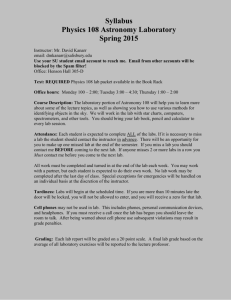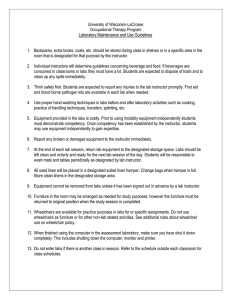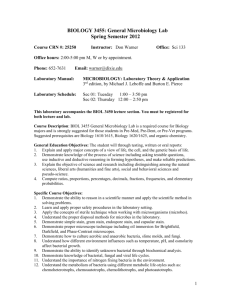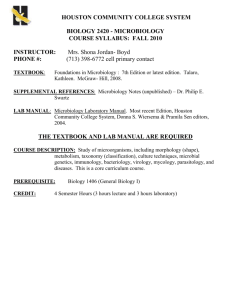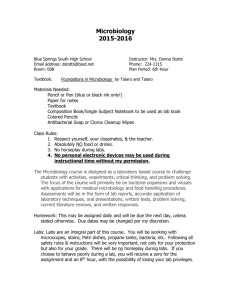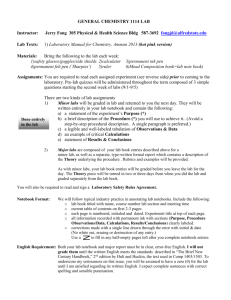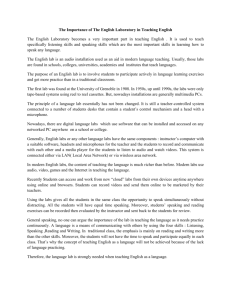Gyure Powerpoint presentation - Western Connecticut State University
advertisement
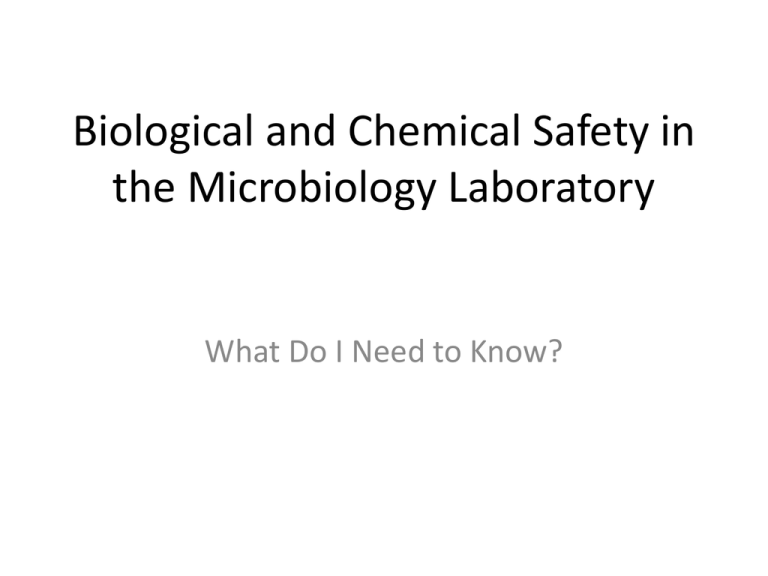
Biological and Chemical Safety in the Microbiology Laboratory What Do I Need to Know? RESPONSIBILITIES IN ALL LABS: • Think about the kinds of risks and hazards in your lab..both biological and chemical. There are many resources and guides. See links. • Have a plan to address the risks..implement and monitor it. • Be sure to involve authorities at your college and at state level if required.. They are your allies and can provide valuable and necessary assistance. AS AN INSTRUCTOR OF MICROBIOLOGY: • Make the rules clear and insist (from day one) that discipline and professional behavior in the laboratory is absolutely required. Lack of rigorous discipline is often the reason why students lapse as they may not take you seriously. • There should be consequences for students who do not take policies seriously. • Explain that in a microbiology laboratory, biosafety concerns add to the list of required precautions above and beyond those in other labs at the university. • Be a conscientious modeler of every regulation . Never take short cuts or let students see you bending or breaking the rules– even when working alone in the lab. OTHER CONSIDERATIONS: • Clinical labs • Experimentation involving human or animal subjects • Researchers with NIH or NSF grant funding, etc. Basic Safety Your university has emergency response guidelines but be sure your students know what to do if they are in your lab when something happens..rooms and buildings differ. Describe, discuss, post information ..and have contingency plan if you are unconscious. Chemical Safety We all use chemicals in our labs. In the lab there should be access to a database of MSDS information about all of them in case of accident or spill. There are many different ways that labs and universities do this. No eating or drinking in the lab..of course. I don’t allow cough drops, gum etc…anything that goes in the mouth. Proper footware is essential. I keep “slippers of shame” (cheap plastic clogs) for students who forget. But they don’t forget if you are strict. Other details like pulling back long hair is an excellent idea. Lab coat… must be worn properly and other considerations will be discussed. Mouth pipetting? Goggles. Storage of flammables. Non denatured 200proof alcohol is also regulated..you must keep records of usage. Labeling of chemicals and solutions is important. Anything normally found in a kitchen, or thought of as “food” needs to be labeled otherwise. Storage of corrosives like strong acids and bases. Possible exposure to chemical powders… All chemical waste MUST be collected, properly labeled and sent for appropriate disposal . Yes – there are costs associated, so less waste is to everyone’s advantage. Waste satellite area must be set up in each room where waste is generated. Proper labels should be provided and guidelines for collection and disposal. Spill kits should be available as part of risk assessment response plan. Accidents happen..plan for them. Biological Safety Biological Safety Cabinet..there are many types for different applications. They are NOT the same as a chemical fume hood. Security and storage of stock cultures. Master list of cultures is available where they are stored. All equipment and each room where there are cultures being used is labeled as BOHAZARD. Biological waste must be disposed of properly. Bench disinfection HAND HYGIENE Proper use of gloves! Control of potential “intruders.” Aerosols and droplets STUDENT AGREEMENT ON LABORATORY SAFETY I have read the Laboratory Policy Statement of the Department of Biological and Environmental Sciences, Western CT State University, and I understand its content. I agree to abide by all laboratory and/or field rules set forth by the instructor. I agree to inform the instructor, in writing, of any personal condition which may render a laboratory or field experience unsafe for me or others prior to my participation in that laboratory or field experience. If I am at special risk for any of the reasons explained in the policy statement, I will discuss the situation with my physician before proceeding with the course. I understand that my safety is entirely my own responsibility and that I may be putting myself and others in danger if I do not abide by all the rules set forth by the instructor and/or if I do not provide relevant information as stated above. COURSE: BIO 215 (MICROBIOLOGY) FALL 2010 NAME OF STUDENT (PRINT) ________________________ SIGNATURE OF STUDENT ________________________ STUDENTS MUST UNDERSTAND RISKS AND RULES. ELICIT THEIR COOPERATION AND AGREEMENT ON DAY ONE.
